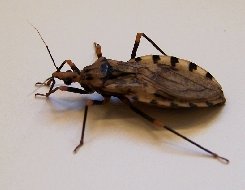Triatominae
Triatominae é uma subfamília de insetos da família Reduviidae. Várias espécies desta subfamília atuam como vetores na transmissão da doença de Chagas.[1] Os triatomíneos são chamados popularmente, no Brasil, de barbeiro, chupão, chupança, fincão, furão, bicudo, percevejão, bicho-de-parede, bicho-de-parede-preto, percevejo-do-sertão, percevejo-francês, percevejo-gaudério, percevejo-grande, procotó, porocotó, baratão, bruxa, cafote, cascudo, piolho-de-piaçava, quiche-do-sertão, rondão e vum-vum.[2]
| Triatominae | |||||||||||||
|---|---|---|---|---|---|---|---|---|---|---|---|---|---|
| Classificação científica | |||||||||||||
| |||||||||||||
| Tribos | |||||||||||||
| ver texto | |||||||||||||
Taxonomia
editarA subfamília Triatominae está dividida em seis tribos:[3]
- Tribo Alberproseniini Martínez & Carvalho, 1977
- Alberprosenia Martínez & Carvalho, 1977
- Tribo Bolboderini Usinger, 1944
- Belminus Stal, 1859
- Bolbodera Valdés, 1910
- Microtriatoma Prosen & Martínez, 1952
- Parabelminus Lent, 1943
- Tribo Cavernicolini Usinger, 1944
- Cavernicola bieber, 1937
- Tribo Linshcosteini Carcavallo, Jurberg, Lent, Noireau & Galvão, 2000
- Linshcosteus Distant, 1904
- Tribo Rhodniini Pinto, 1926
- Psammolestes Bergroth, 1911
- Rhodnius Stal, 1859
- Tribo Triatomini Jeannel, 1909
- Dipetalogaster Usinger, 1939
- Eratyrus Stal, 1859
- Hermanlentia Jurberg & Galvão, 1997
- Meccus Stal, 1859
- Mepraia Mazza, Gajardo & Jörg, 1940
- Nesotriatoma Usinger, 1944
- Panstrongylus Berg, 1879
- Paratriatoma Barber, 1938
- Triatoma Laporte, 1832
Inicialmente o clado era tratado como uma família distinta de Reduviidae, mas foi reduzido a subfamília.[4] As relações taxonômicas do grupo ainda não estão totalmente resolvidas, alguns estudos demonstram que o clado é monofilético,[5][6] outros, polifilético;[7][8] ou ainda parafilético.[9]
O gênero Torrealbaia, descrito em 1998, foi sinonimizado, em 2004, com o Amphibolus.[10]
Referências
- ↑ Guerrant, R.L.; Walker, D.H.; Weller, P.F. Tropical Infectious Diseases Principles, Pathogens, & Practice 2 ed. Philadelphia: Churchill Livingstone Elsevier. pp. 1082–1094
- ↑ Lent, H (1999). «Evolução dos conhecimentos sobre vetores da doença de Chagas 90 Anos após sua descoberta». Memórias do Instituto Oswaldo Cruz. 94 (suppl 1): 89-92
- ↑ Galvão, C.; Carcavallo, R.; da Silva Rorcha, D.; Jurberg, J (2004). «A checklist of the current valid species of the subfamily Triatominae Jeannel, 1919 (Hemiptera, Reduviidae) and their geographical distribution, with nomenclatural and taxonomic notes». Zootaxa. 202: 1-36
- ↑ Usinger, R.L (1943). «A revised classification of the Reduvioidea with a new subfamily from South America». Annals of the Entomological Society of America. 36 (4): 602-618
- ↑ Weirauch, C.; Munro, J.B (2009). «Molecular phylogeny of the assassin bugs (Hemiptera: Reduviidae), based on mitochondrial and nuclear ribosomal genes». Molecular Phylogenetics and Evolution. 53 (1): 287–299. doi:10.1016/j.ympev.2009.05.039
- ↑ Patterson, J.S.; Gaunt, M.W (2010). «Phylogenetic multi-locus codon models and molecular clocks reveal the monophyly of haematophagous reduviid bugs and their evolution at the formation of South America». Molecular Phylogenetics and Evolution. 56 (2): 608–621. doi:10.1016/j.ympev.2010.04.038
- ↑ de Paula, A.S.; Diotaiuti, L.; Schofield, C.J (2005). «Testing the sister-group relationship of the Rhodniini and Triatomini (Insecta: Hemiptera: Reduviidae: Triatominae)». Molecular Phylogenetics and Evolution. 35 (3): 712–718. doi:10.1016/j.ympev.2005.03.003
- ↑ Schofield, C.J.; Galvão, C (2009). «Classification, evolution, and species groups within the Triatominae». Acta Tropica. 110 (2-3): 88–100. doi:10.1016/j.actatropica.2009.01.010
- ↑ Hwang, W.S.; Weirauch, C (2012). «Evolutionary History of Assassin Bugs (Insecta: Hemiptera: Reduviidae): Insights from Divergence Dating and Ancestral State Reconstruction». PLoS ONE. 7 (9): e45523. doi:10.1371/journal.pone.0045523
- ↑ Forero, D.; Weirauch, C.; Baena, M (2004). «Synonymy of the reduviid (Hemiptera: Heteroptera) genus Torrealbaia (Triatominae) with Amphibolus (Harpactorinae), with notes on Amphibolus venator (Klug, 1830)». 670: 1-12
